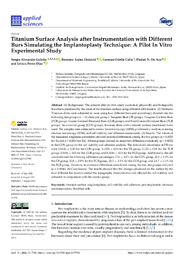Por favor, use este identificador para citar o enlazar este ítem:
https://hdl.handle.net/11000/28626Registro completo de metadatos
| Campo DC | Valor | Lengua/Idioma |
|---|---|---|
| dc.contributor.author | Gehrke, Sergio | - |
| dc.contributor.author | Dedavid, Berenice Anina | - |
| dc.contributor.author | Odella Colla, Germán | - |
| dc.contributor.author | De Aza, Piedad | - |
| dc.contributor.author | Pérez-Díaz, Leticia | - |
| dc.date.accessioned | 2022-12-14T10:30:23Z | - |
| dc.date.available | 2022-12-14T10:30:23Z | - |
| dc.date.created | 2022-08 | - |
| dc.identifier.citation | Applied Sciences; v. 12 , nº 15 | es_ES |
| dc.identifier.issn | 2076-3417 | - |
| dc.identifier.uri | https://hdl.handle.net/11000/28626 | - |
| dc.description.abstract | Background: The present pilot in vitro study evaluated, physically and biologically, the effects produced by the wear of the titanium surface using different drill models. (2) Methods: Titanium disks were subjected to wear using four different burs and accordingly divided into the following test groups (n = 12 disks per group): Tungsten Burs (TB group), Tungsten Carbide Burs (TCB group), Coarse-Grained Diamond Burs (CGB group), and Fine-Grained Diamond Burs (FGB group). As a control group (CON group), titanium disks with a smooth surface (machined) were used. The samples were subjected to atomic force microscopy (AFM), profilometry analysis, scanning electron microscopy (SEM), and cell viability and adhesion assessments. (3) Results: The values of the measured roughness parameters showed statistical differences among the five groups (p = 0.0035 for Ra and p = 0.0010 for Rz). All test groups showed an important difference statistically (p = 0.0032) to the CON group for the cell viability and adhesion analysis. The data of cell absorbance at 570 nm were 0.4122 0.05 for the CON group, 0.1354 0.02 for the TB group, 0.123 0.01 for the TCB group, 0.1414 0.02 for the CGB group, and 0.1216 0.03 for the FGB group. Additionally, the cell count showed the following adherence percentages: 57.6 4.6% for the CON group, 22.9 3.3% for the TB group, 23.4 2.9% for the TCB group, 22.5 3.1% for the CGB group, and 23.7 3.3% for the FGB group. However, no statistical differences were found among the four test groups analyzed (p = 0.3916). (4) Conclusions: The results showed that the changes produced on the surface by the four different bur models altered the topography characteristics and affected the cell viability and adhesion in comparison with the control group | es_ES |
| dc.description.sponsorship | The author Sergio Alexandre Gehrke was funded by a post-doctoral grant nº 2021/PER/00020 from the Ministerio de Universidades under the program “Ayudas para la recualificación del sistema universitario español de la Universidad Miguel Hernandez” modalidad “Margarita Salas para la formación de jóvenes doctores”. The funders had no role in the study design, data collection and analysis, decision to publish, nor preparation of the manuscript. The authors thank M.A. Duhagon for kindly providing the cells for this experiment. | - |
| dc.format | application/pdf | es_ES |
| dc.format.extent | 10 | es_ES |
| dc.language.iso | eng | es_ES |
| dc.rights | info:eu-repo/semantics/openAccess | es_ES |
| dc.rights | Attribution-NonCommercial-NoDerivatives 4.0 Internacional | * |
| dc.rights.uri | http://creativecommons.org/licenses/by-nc-nd/4.0/ | * |
| dc.subject | titanium surface; implantoplasty; cell viability and adhesion; peri-implantitis; titanium instrumentation; fibroblast cells | es_ES |
| dc.subject | implantoplasty | es_ES |
| dc.subject | cell viability and adhesion | es_ES |
| dc.subject | peri-implantitis | es_ES |
| dc.subject | titanium instrumentation | es_ES |
| dc.subject | fibroblast cells | es_ES |
| dc.subject.other | CDU::6 - Ciencias aplicadas::62 - Ingeniería. Tecnología | es_ES |
| dc.title | Titanium Surface Analysis after Instrumentation with Different Burs Simulating the Implantoplasty Technique: A Pilot In Vitro Experimental Study | es_ES |
| dc.type | info:eu-repo/semantics/article | es_ES |
| dc.contributor.institute | Institutos de la UMH::Instituto de Bioingeniería | es_ES |
| dc.identifier.doi | 10.3390/app12157920 | - |
| dc.relation.publisherversion | https://doi.org/10.3390/app12157920 | - |

Ver/Abrir:
2022 applsci-Sergio.pdf
2,71 MB
Adobe PDF
Compartir:
 La licencia se describe como: Atribución-NonComercial-NoDerivada 4.0 Internacional.
La licencia se describe como: Atribución-NonComercial-NoDerivada 4.0 Internacional.
.png)